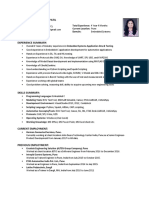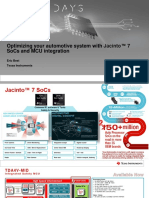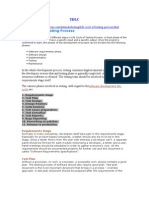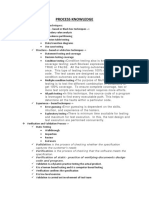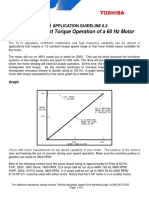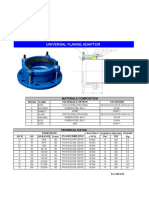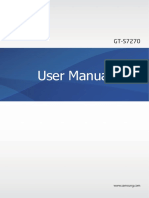Red Bend Update Car Ecu PDF
Uploaded by
tomsiriRed Bend Update Car Ecu PDF
Uploaded by
tomsiriUpdating Car ECUs Over-The-Air
(FOTA)
White Paper
Updating Car ECUs Over-The-Air (FOTA)
White Paper
ABSTRACT
As the amount of software in automobiles grows, so too does the need to effectively manage that
software asset. The telecom industry has a proven solution for remotely updating software on
mobile devices. The technology is called Firmware Over-the-Air (FOTA) updating. All major mobile
phone manufacturers and tier one operators have adopted FOTA successfully, performing more
than 100 million updates per year with the benefit of providing new features and performance
improvements, reducing customer care costs, avoiding product recalls, and increasing consumer
satisfaction. FOTA technology is now entering the automotive industry. This paper describes the
existing update methodology in the automotive industry, its pros and cons, and the benefits of
using FOTA in automotive.
INTRODUCTION
1.1
Software in Automobiles
Todays automobile contains many complex electronic systems; each may incorporate a large
number of Electronic Control Units (ECUs) performing a single function and communicating via a
common bus/network.
In a 2009 article in IEEE Spectrum, Prof. Manffred Broy says that in a premium class automobile
there are close to 100 million lines of software codes, compared to the F-35 Joint Strike Fighter
with 5.7 million lines or with the Boeing 787 with about 6.5 million lines.
According to the article, Alfred Katzenback, the director of information technology management at
Daimler, said that the radio and navigation system in the 2009 S-Class require over 20 million lines
of code alone and that the car contains nearly as many ECU s as the new Airbus A380 (excluding
the planes in-flight entertainment system).
In addition, Prof. Broy states in the article that the cost of software and electronics can reach 35
to 40 percent of the cost of a car.
Present day automobiles typically contain more than 60 ECUs such as the audio system, brake
system, doors, lighting, engine, transmission, batteries, and more. The embedded software
package size is now tens of megabytes for engine and transmission controllers, while
audio/infotainment systems are usually the largest and most complicated software units, often
exceeding 100MB.
1.2
Warranty Claims
Warranty-claim cost in the automotive industry is very significant and accounts for $1,100 on an
average per vehicle in the European Union (Warranty Week, July 7, 2011). In the U.S., the numbers
are lower than in the EU and are less than $500 on average.
The total automotive warranty costs for 2010 in the U.S. was close to $4.7B (Warranty Week,
September 21, 2011). Warranty Week published figures of warranty claims per several OEMs
ranging from 0.9% in Honda (of the Average Selling Price) to 4% in Volkswagen (refer to the figure
below).
In an article that was written by Manjunath S (Software in Motion, August 2011), IBM claims that
approximately 50 percent of the car warranty costs are now related to electronics and their
2011, Red Bend Ltd. All Rights Reserved.
[2 of 14]
Confidential
Updating Car ECUs Over-The-Air (FOTA)
White Paper
embedded software, which means that if the automotive industry will use FOTA updating it could
provide a significant leap forward towards reducing warranty costs.
Figure 1: Different OEMs and Their Warranty Cost as a Percentage of Product Sales
Figure 2: Japanese Automotive OEMs Product Warranty Accruals 2003-2011 as a % of
Automotive Revenue
2011, Red Bend Ltd. All Rights Reserved.
[3 of 14]
Confidential
Updating Car ECUs Over-The-Air (FOTA)
White Paper
Embedded Software Update in Automobiles
TODAY
There are many control modules in a vehicle, most of which are interconnected over some form of
vehicle network interface (CAN, MOST, LIN, FlexRay). However, only a select few will have access
to external cellular or Wi-Fi networks, typically the infotainment head unit or Telematics module.
It is possible to use an externally connected module as a gateway for updates, where firmware
updates for other modules are received by this gateway module and then transferred to the
appropriate module over a vehicle network. In any case, each of the vehicle control modules will
potentially be subject to updates.
There are several use cases today for updating automobile software:
Recall (mandatory or voluntary)
During scheduled maintenance
Customer complaint
Delivering new features and applications
The recall case is the most common, and involves the following process:
1
A vehicle manufacturer finds a problem with the vehicle functionality. The affected
functionality can be fixed by changing software in one of the vehicles ECUs.
The appropriate ECU supplier is requested to provide a new release. The supplier ships the
software release to the Original Equipment Manufacturer (OEM), which tests it for quality
assurance (QA).
The OEM notifies the dealers and owners of the recall via mail. The OEM sends the new
software version to the dealers on a CD by mail as well. The dealer updates the
reprogramming (serial communication) tools with the content from the CD.
The vehicle owner drops off the vehicle at the dealer shop and registers at the front desk.
The technician connects a serial communication tool to the in-vehicle bus to access the
targeted ECU.
The technician starts the update process of the targeted ECU.
The technician checks the targeted ECU for the new software version to make sure proper reflashing happened.
The customer picks up the updated vehicle.
The dealer charges the OEM for the recall labor.
The update duration changes significantly depending on the module size and the speed of the
serial protocol; however due to a lot of overhead, dealers are charging 1-2 hours of labor for such
activity. There are some car models where the update can take more than 2 hours. It should be
noted that programming tools are rather expensive, so there is a limit to the number of
simultaneous re-programming.
2011, Red Bend Ltd. All Rights Reserved.
[4 of 14]
Confidential
Updating Car ECUs Over-The-Air (FOTA)
White Paper
2.1
Assessment of the Current Reprogramming (CableBased) Method
There are limitations and constraints with current software distribution and software update
processes:
Any update is distributed to all dealers. This takes time and resources. It may also cause
delays in getting the latest software to the vehicles. In addition, all dealers need to maintain a
software version library, which consumes resources.
The download process and the manual setup take a long time, resulting in higher cost of
labor, inconvenience, and customer dissatisfaction. Due to this long duration, the consumer
needs to drop off the vehicle and return later to pick it up a major inconvenience.
The process cannot be scaled or preformed in parallel, as it involves a physical equipment
connection.
Some existing re-flashing methods require sequential updates, meaning from version 1 to 2
to 3, which can make the entire update process longer.
Sometimes (for off-highway vehicles), the re-flashing equipment needs to be mobilized to the
vehicle.
It may take a long time from when the customer is notified to the time the vehicle is actually
updated. Many customers do not respond to recall notices. For older vehicles, the OEM may
not have the latest vehicle owner information, meaning some vehicles never receive needed
updates. Conducting a successful recall depends on the customer cooperation.
Reprogramming of the ECU is performed manually.
The customer becomes aware of the problem and overall customer satisfaction decreases.
There are some advantages to the current reprogramming (cable-based) method:
While FOTA is gaining wide acceptance for new automotive platforms, it will take few years
until FOTA is a widely adopted solution in the automotive industry.
Reprogramming is performed in the controlled environment.
The vehicle is not moving and it is under technician supervision while the reprogramming
occurs.
This methodology is proven and it has worked in the past.
Any problem that occurs has more chances to be detected immediately by a trained
technician.
Vehicle wired serial communication protocols and algorithms for reprogramming are
proprietary and closed source by nature. As such, protocols provide an added layer of
security against unauthorized software changes.
2011, Red Bend Ltd. All Rights Reserved.
[5 of 14]
Confidential
Updating Car ECUs Over-The-Air (FOTA)
White Paper
Firmware Over-The-Air (FOTA) Update
Technology
The FOTA update process comprises three primary stages: generating the update, managing the
delivery of the update, and performing the update.
Figure 1 : Typical FOTA Solution High-Level Architecture
3.1
Generating the Update Package
To perform a FOTA update, a software update package containing defect fixes or new features
must be generated. In order to make this package as small as possible (in general it is less than 5%
of the original size), the update package includes only the changes (also referred to as the delta)
between the version that already exists on the ECU and the new version being deployed to the
vehicle. This update package is typically generated by the owner of the software, most often a tier
I vendor.
3.2
Managing the Delivery of the Update Package
Once generated, the update package is published to a distribution platform. In the mobile
industry, this platform is managed by either the mobile phone manufacturer or the network
operator. In automotive, this platform is managed by the OEM. This platform manages the various
versions of the update packages and handles the actual network delivery (download) of the
packages to the appropriate vehicle model and specific ECU. There are typically multiple versions
of update packages, each intended for particular vehicle models and configurations. This portion
of the process can be an integral part of an overall Telematics or over-the-air (OTA) diagnostics
system.
A centralized software package repository is used for the FOTA use cases, which are described
below. This centralized repository replaces the distribution of software updates to the various
dealers. It significantly reduces the Time-To-Market (TTM) of any new software version. This
system is also responsible for the delta package delivery to the device. There are several ways to
perform such a delivery. In mobile, most market players use a standard protocol developed
through the Open Mobile Alliance Device Management (OMA-DM) organization.
2011, Red Bend Ltd. All Rights Reserved.
[6 of 14]
Confidential
Updating Car ECUs Over-The-Air (FOTA)
White Paper
3.3
Performing the Update
In this third stage of the process, the downloaded update package is used to perform the actual
update (re-flashing) of the original software image. The update package and the FOTA update
software necessary to perform the update occupy a small amount of memory allocated within the
embedded device in the vehicle (to address the challenges associated with the limited memory
resources). In this stage, the FOTA update software validates that the correct update package has
been received and that the update process has been successfully completed. It is important to
mention that the FOTA updates do not need to be sequential and can support any-to-any software
version update.
2011, Red Bend Ltd. All Rights Reserved.
[7 of 14]
Confidential
Updating Car ECUs Over-The-Air (FOTA)
White Paper
FOTA - Changing the ECU Update Paradigm
The current method of updating software in cars was suitable when the amount of software was
minimal. Now that software has become vital to the operation and feature-set of cars, the method
of software updating must be improved.
It is clear that performing the update in the customer location and not in the dealership represents
a better and more optimized method in term of cost savings and user experience. However, it can
introduce some potential procedure challenges such as how to make sure that the car will not be
driven in the middle of the update. Therefore, FOTA adoption in the automotive industry will take
more time to become fully operational.
4.1
Dealership FOTA Scenario
This section describes the OTA dealership use case. The FOTA operation when customers are
staying at home is described in the next subsection. Initially, the Dealership FOTA use case may
be adopted more quickly as it addresses the reliability and liability concerns of the OEMs. Once
FOTA updates are performed more frequently, other use cases, much more cost effective, could
be implemented.
The use case description is as follows:
1
A vehicle manufacturer finds a problem with the vehicle functionality. The affected
functionality can be fixed by modifying the software in one of the vehicles ECUs.
The appropriate vendor is requested to provide a new delta release. The vendor ships the
delta release to the OEM.
The OEM notifies the dealers and owners of the recall via mail. The OEM may send the new
version to the dealers using a CD by mail as well as electronically.
The vehicle owner drops off the vehicles at the dealer shop and registers at the front desk.
The technician requests a software update via FOTA to be immediately initiated with the
specified vehicle. The main server authenticates against the vehicle and confirms process
start.
The FOTA process is executed over-the-air (OTA); the delta file is downloaded and updated. A
completion status is provided once the process is done (the whole process lasts less than 15
minutes).
The vehicle is checked to make sure proper re-flashing happened.
Customer picks up the vehicle.
The dealer charges the OEM for labor, probably 30 minutes for software operation and
checkup.
2011, Red Bend Ltd. All Rights Reserved.
[8 of 14]
Confidential
Updating Car ECUs Over-The-Air (FOTA)
White Paper
Some notes to the above process:
4.2
Since the software is maintained centrally by the OEM, the dealers do not need to spend time
on storing and managing new updates.
The process can be executed simultaneously to many cars (10-50), so the limitation of a
programming tool is not a bottleneck.
The vehicle does not need to be positioned inside the garage. It can be parked outside. This
saves a lot of time and allows the scale of the process beyond the garage vehicle capacity. In
addition, the vehicle owner may not have to leave the dealership at all.
In case of a power failure, the process restarts from the last written block, saving a lot of time
of re-flashing blocks that were already written.
In some instances, this update might simply involve swap out of the ECU hardware module.
FOTA at the Customer Location Scenario
This section describes the use case of performing FOTA updates at the customer location. This
provides the customer with maximum convenience and OEM cost savings will be maximized.
The use case description is as follows:
1
A vehicle manufacturer finds a problem with the vehicle functionality. The affected
functionality can be fixed by changing software in one of the vehicles ECUs.
The appropriate vendor is requested to provide a new delta release. The vendor ships the
delta release to the OEM.
The OEM notifies the dealers and owners of the recall via mail. The OEM does not send the
new version to the dealers, since the centralized system is used to store all software versions.
The vehicle owner calls the dealer and requests a FOTA update. The dealer requests that the
owner will keep the car parked (home or office).
The technician requests a remote software update (FOTA) process to be immediately
initiated with the specified vehicle. The main server authenticates itself with the vehicle and
confirms the process start.
The FOTA process is executed OTA (the delta file is downloaded and updated). A completion
status is provided once the process is done (usually less than 15 minutes).
The owner is notified to perform a check on his/her vehicle to make sure it is operational.
The dealer charges the OEM for labor (probably 15 min for software operation and vehicle
checkup).
This process could be implemented using an Interactive Voice Response (IVR) to save costs.
2011, Red Bend Ltd. All Rights Reserved.
[9 of 14]
Confidential
Updating Car ECUs Over-The-Air (FOTA)
White Paper
Some notes to the above process:
4.3
The software update packages are maintained centrally by the OEM so the dealer does not
need to spend time on storing new updates.
The process can be executed simultaneously to many cars (hundreds and thousands), so the
limitation of a programming tool is not a bottleneck.
The vehicle is located at the customer location, so the dealer garage parking space does not
pose any limitation.
The OEM can use an Interactive Voice Response (IVR) utility to further scale the process and
save on labor.
Incentives to Using FOTA for Automotive
There are many incentives to use FOTA in automotive, including the following:
4.4
Warranty cost reduction recall cost will go down. The technicians and customers time is
saved.
Location independent wireless communication can provide a method for vehicles to be
updated without requiring their physical presence at the dealer.
Shorter correction cycle product as well as software development is subject to rigorous
developmental processes, tests, and reviews. Re-flashing existing ECUs in the field adds to the
quality of the product.
Centralized server all updates are located in a centralized server and are not distributed to
thousands of dealers. This saves potential errors and ensures that the latest software is
installed. In addition, it reduces the Time-To-Market (TTM) for new software updates.
Convenience consumer convenience is already achieved using the dealership FOTA model.
When the FOTA is performed at the consumer location, convenience is maximized.
Allows for forced updates in some cases, re-programming could be done regardless of
customer willingness to cooperate (such as safety related recalls).
Improves safety applying wireless software updates decreases the time the recalled vehicle
is driven under faulty conditions.
Proven technology FOTA is a proven technology used in the telecom industry on more than
1 billion mobile phones and connected wireless devices. In addition, cellular service inside
automobiles is very robust and available, so there should be no issue in coverage and
reception.
There is no need to have a fully trained technician to perform the update.
Granularity of Updates and User Involvement
In general, in a given module there may be a variety of software components that are
independently updatable. Using a modern infotainment system as an example, these might
include a base firmware image, a navigation system, a music/multimedia database, voice
recognition system, and other upgradable software components. Some updates might be
considered mandatory, while others may be provided on-demand or with user approval. A quiet
update might be preferred for mandatory push updates, while a more user-engaging approach
will be preferred for elective updates or those that require end-user approval.
2011, Red Bend Ltd. All Rights Reserved.
[10 of 14]
Confidential
Updating Car ECUs Over-The-Air (FOTA)
White Paper
In an extreme case, a user-directed update might contain entirely new features and applications,
as typically made available through an App Store. In this case, an inventory of available content is
provided to the user, from which new features can be selected. The same FOTA update
mechanisms can be engaged to facilitate such an update.
4.5
Other Use Cases for Performing FOTA
There are three areas where FOTA is already in production cars:
In-Vehicle Infotainment (IVI)
Electrical Vehicle (EV)
Telematics Units
There are several reasons why car manufactures and tier 1 OEMs have decided to implement
FOTA in these automotive systems. The frequent number of changes to the component code
requires using new and proven methods for doing over the air updates. In addition, using FOTA
with the ability to send over-the-air only the changes between the versions allows car
manufactures and service providers to reduce costs by saving cellular and roaming expenses.
2011, Red Bend Ltd. All Rights Reserved.
[11 of 14]
Confidential
Updating Car ECUs Over-The-Air (FOTA)
White Paper
FOTA Considerations
Most of the considerations which are described below are already addressed by the telecom
industry, and the automotive industry could leverage these proven standards and protocols.
5.1
5.2
Technical Considerations
Download protocol a method needs to be implemented to securely and reliably transfer
software packages wirelessly from the vehicle manufacturer to the targeted vehicles ECUs.
The telecom OMA-DM standard provides a viable option for automotive.
Outside/cellular channel at least one wireless-capable component needs to act as a wireless
gateway and must be connected with the other embedded systems using internal buses or
Bluetooth.
Multiple devices in the vehicle there are multiple devices that need to be updated. It does
not make economic sense that each one of them will have an external wireless channel for
updating. The same gateway concept described above could be used.
The ability to support multiple communication protocols such as cellular and Wi-Fi.
The re-flashing process should be considered when calculating the battery lifetime.
The vehicle needs to be in a wireless reception area in order to download the new software
version over the air.
It is possible to separate the download process from the update process so that the update
process can be performed even in areas without wireless reception
The storage will slightly increase to store the delta and the update agent.
The FOTA updating system must be capable of updating both the Read/Write and the Writeonly area in the memory.
The FOTA updating system must minimize the download and the update time.
Customer and Process Considerations
Updating software that will alter vehicle functionality without consent may upset the customer.
The customer may notice a change in the vehicle functionality that will lead him/her to think that
there is a problem in the vehicle. A customer needs to be informed of the software update. A good
example is a display on the instrument panel indicating that a software update occurred. The
display could show software change identification (SCID). A customer can then log on to the
vehicle manufacturers website and look up the SCID to find out more information about the
software change.
The FOTA updating system must be able to intelligently decide which wireless technology to use
based on the location of the vehicle. For example, when the car is parked at home, the FOTA
update may be performed over Wi-Fi and not cellular.
The industry must establish procedures for when to perform the update. For example, processes
and safeguards must be put in place so that ECUs are not updated while they are performing a
vehicle function, and only when the vehicle is not moving and the ignition key is set to the off
position.
2011, Red Bend Ltd. All Rights Reserved.
[12 of 14]
Confidential
Updating Car ECUs Over-The-Air (FOTA)
White Paper
5.3
Dealer Issues
The dealers will lose a significant revenue source with the reduction of maintenance labor
required for software updates.
In the beginning, the process will not be ubiquitous, since not all systems could have OTA updates.
This may be a source for confusion.
5.4
Vehicle Manufacturer (OEM) Considerations
The vehicle manufacturer must keep track of each individual vehicles ECUs and software releases
including the dependency between the ECUs. The list must be updated when a particular ECU
software is updated.
Developing the right testing and validation process, the vehicle must operate properly after the
software update. Under no circumstances the updating process should affect safety of the
passengers integrity of the software after re-flashing in the targeted ECU must be guaranteed.
Building the back-end infrastructure that will be responsible for sending the updates over the air
to the cars. In some cases, this infrastructure should be connected to other systems, such as
customer care or billing, since it can be used also as the delivery system for the application store.
2011, Red Bend Ltd. All Rights Reserved.
[13 of 14]
Confidential
Updating Car ECUs Over-The-Air (FOTA)
White Paper
Summary
The car industry is going through the same trend that the mobile industry experienced eight years
ago, where the need to maintain the increasing amount of software is forcing the industry to look
for new, more efficient, and more cost-effective methods. Updating car ECUs has become a
mandatory operation. The current mode of doing an update is costly, not customer friendly, and
not flexible enough to cope with the rapid changes that are happening in the car industry.
FOTA technology is a proven, safe, and cost-effective method for OEMs and car manufactures to
manage the car software evolution, which is turning the car from iron driven to code driven.
FOTA can help auto makers to save time and costs, mitigate risk, and attract and retain
customers. In addition, this can enable car manufactures to establish new ways of up-selling
services and deliver new features and applications to consumers throughout the car lifecycle.
Changing the existing update methodology to FOTA should be gradually performed. With the
experience and lessons learned in the telecom industry, this migration can be smooth and
successful for the automotive industry.
2011, Red Bend Ltd. All Rights Reserved.
[14 of 14]
Confidential
You might also like
- Hybrid Vehicle Dismantling Manual For ATH20 - Alphard HV PDF80% (5)Hybrid Vehicle Dismantling Manual For ATH20 - Alphard HV PDF39 pages
- Hypervisor Overview Application Note Hypervisor Description ALL REV 0.00No ratings yetHypervisor Overview Application Note Hypervisor Description ALL REV 0.0027 pages
- Programming With Posix Threads (Libro) PDFNo ratings yetProgramming With Posix Threads (Libro) PDF398 pages
- Testing Before You Download and Install FirmwareNo ratings yetTesting Before You Download and Install Firmware5 pages
- OperManual SB ST310U Rev112 09 12 2017 PDFNo ratings yetOperManual SB ST310U Rev112 09 12 2017 PDF67 pages
- Customer Friendly Release Notes JBL Bar 9.1 Surround and Upgrade Process Global Version 21-23-11 80No ratings yetCustomer Friendly Release Notes JBL Bar 9.1 Surround and Upgrade Process Global Version 21-23-11 802 pages
- Globalplatform Card Uicc Configuration: Member ReleaseNo ratings yetGlobalplatform Card Uicc Configuration: Member Release50 pages
- Optimizing Your Automotive System With Jacinto™ 7 Socs and Mcu IntegrationNo ratings yetOptimizing Your Automotive System With Jacinto™ 7 Socs and Mcu Integration18 pages
- TP SDV in Action From Tech To New ExperiencesNo ratings yetTP SDV in Action From Tech To New Experiences36 pages
- Process Knowledge: Test Case Design TechniquesNo ratings yetProcess Knowledge: Test Case Design Techniques2 pages
- Senior Test Engineer - Hyderabad - Secunderabad - Aveva - 7 To 10 Years of ExperienceNo ratings yetSenior Test Engineer - Hyderabad - Secunderabad - Aveva - 7 To 10 Years of Experience3 pages
- Subrahmanya HN: Software Project Manager - Senior Safe Scrum Master & Agile CoachNo ratings yetSubrahmanya HN: Software Project Manager - Senior Safe Scrum Master & Agile Coach4 pages
- Advanced Management Programme in Business AnalyticsNo ratings yetAdvanced Management Programme in Business Analytics18 pages
- US DOT - Cybersecurity Best Practices For The Safety of Modern VehiclesNo ratings yetUS DOT - Cybersecurity Best Practices For The Safety of Modern Vehicles24 pages
- Automatic Simulation Measurement and Verification of Inputs and Outputs of Body Control ModuleNo ratings yetAutomatic Simulation Measurement and Verification of Inputs and Outputs of Body Control Module4 pages
- CAN Bus Reverse Engineering Using Vehicle Spy 3No ratings yetCAN Bus Reverse Engineering Using Vehicle Spy 327 pages
- AUT F0615 Automotive Instrument Cluster Solutions From Low Line To Premium Line100% (1)AUT F0615 Automotive Instrument Cluster Solutions From Low Line To Premium Line47 pages
- (Automotive Cybersecurity Best Practices) Auto-IsAC - Awareness and Training (2019, Auto-IsAC) - Libgen - LiNo ratings yet(Automotive Cybersecurity Best Practices) Auto-IsAC - Awareness and Training (2019, Auto-IsAC) - Libgen - Li22 pages
- Automotive Embedded Testing Course - BasivcNo ratings yetAutomotive Embedded Testing Course - Basivc4 pages
- Diagnostics of Software Defined VehiclesNo ratings yetDiagnostics of Software Defined Vehicles4 pages
- Virtual and Augmented Reality For Automobile Industry: Innovation Vision and ApplicationsNo ratings yetVirtual and Augmented Reality For Automobile Industry: Innovation Vision and Applications184 pages
- Automotive Cyber Security: Andi Otea May 2018No ratings yetAutomotive Cyber Security: Andi Otea May 201818 pages
- Embedded Automotive System Development ProcessNo ratings yetEmbedded Automotive System Development Process2 pages
- Mastering Rtos: Hands On Freertos and Stm32Fx With DebuggingNo ratings yetMastering Rtos: Hands On Freertos and Stm32Fx With Debugging348 pages
- Design Process Hardware Autosar: Present Problems The Autosar StandardNo ratings yetDesign Process Hardware Autosar: Present Problems The Autosar Standard3 pages
- Diagnostic Communication Manager Module in AUTOSAR100% (1)Diagnostic Communication Manager Module in AUTOSAR7 pages
- Service Oriented Architecture For Software Driven VehiclesNo ratings yetService Oriented Architecture For Software Driven Vehicles13 pages
- Systems Engineering for All: Introduction to Systems Engineering for non-Systems EngineersFrom EverandSystems Engineering for All: Introduction to Systems Engineering for non-Systems EngineersNo ratings yet
- A New Kind of Motor - Lenze MF 120Hz Inverter Optimised Motor - Cornfield Engineering SolutionsNo ratings yetA New Kind of Motor - Lenze MF 120Hz Inverter Optimised Motor - Cornfield Engineering Solutions2 pages
- Ltpowercad Ii V2.0 Design Tool User'S GuideNo ratings yetLtpowercad Ii V2.0 Design Tool User'S Guide60 pages
- 120 HZ Constant Torque Operation of A 60 HZ Motor: Application Guideline 8.2No ratings yet120 HZ Constant Torque Operation of A 60 HZ Motor: Application Guideline 8.22 pages
- Energies: Modelling and Control of Parallel-Connected Transformerless Inverters For Large Photovoltaic FarmsNo ratings yetEnergies: Modelling and Control of Parallel-Connected Transformerless Inverters For Large Photovoltaic Farms25 pages
- Parallel Installation AxpertKS+MKS 4K 5K PDFNo ratings yetParallel Installation AxpertKS+MKS 4K 5K PDF12 pages
- Wnvkngxgn%Qpxgtvgtukp4Gpgycdng 'Pgti (5 (Uvgou: 4Xhhqvodqg8Qlyhuvlw/Ri7Hfkqrorj/6Fkrrori (Qjlqhhulqj6/Vwhpv $xvwudoldNo ratings yetWnvkngxgn%Qpxgtvgtukp4Gpgycdng 'Pgti (5 (Uvgou: 4Xhhqvodqg8Qlyhuvlw/Ri7Hfkqrorj/6Fkrrori (Qjlqhhulqj6/Vwhpv $xvwudold28 pages
- Advanced Power Electronic Functionality For Renewable Energy Integration With The Power GridNo ratings yetAdvanced Power Electronic Functionality For Renewable Energy Integration With The Power Grid17 pages
- Control of Parallel-Connected Inverters To Achieve Proportional Load SharingNo ratings yetControl of Parallel-Connected Inverters To Achieve Proportional Load Sharing6 pages
- Why Pre-Filtration and Good Cartridge Filtration Is ImportantNo ratings yetWhy Pre-Filtration and Good Cartridge Filtration Is Important2 pages
- Description of Counters Protocol: Jessica@cmdtec - ItNo ratings yetDescription of Counters Protocol: Jessica@cmdtec - It2 pages
- Programming Manual Cellocator CR200-CR200B Rev31d-820% (5)Programming Manual Cellocator CR200-CR200B Rev31d-887 pages
- Gps Tracking With Blackberry Devices: Locate Your Devices, Your Friends, Your Employees WorldwideNo ratings yetGps Tracking With Blackberry Devices: Locate Your Devices, Your Friends, Your Employees Worldwide32 pages
- Ci 2022 0006 Mobilogix MT2000 Protocol Over The Air 01 07 2022 V1 15No ratings yetCi 2022 0006 Mobilogix MT2000 Protocol Over The Air 01 07 2022 V1 1558 pages
- Line Follower and Bluetooth Controlled RobotNo ratings yetLine Follower and Bluetooth Controlled Robot11 pages
- OpenShift - Container - Platform 4.3 Operators en USNo ratings yetOpenShift - Container - Platform 4.3 Operators en US137 pages
- Samsung Galaxy Ace 3 - Schematic Diagarm PDFNo ratings yetSamsung Galaxy Ace 3 - Schematic Diagarm PDF116 pages
- Catalogue - Tetra Devices Software FeaturesNo ratings yetCatalogue - Tetra Devices Software Features36 pages
- LTE Over-The-Air Testing For Base Stations With R&S FSHNo ratings yetLTE Over-The-Air Testing For Base Stations With R&S FSH27 pages
- Infineon-Implementing Health Monitoring and Other Advanced Capabilities-Whitepaper-V01 00-ENNo ratings yetInfineon-Implementing Health Monitoring and Other Advanced Capabilities-Whitepaper-V01 00-EN10 pages











